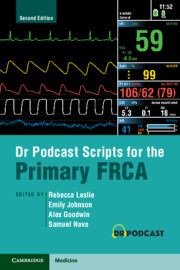Refine search
Actions for selected content:
247 results
Relationship between anaesthesia strategy and intracardiac hemodynamics during paediatric cardiac catheterisation
-
- Journal:
- Cardiology in the Young , First View
- Published online by Cambridge University Press:
- 01 September 2025, pp. 1-8
-
- Article
- Export citation
Cold vs. CO₂: anaesthetic effects on insect antennal functionality
-
- Journal:
- Bulletin of Entomological Research , First View
- Published online by Cambridge University Press:
- 29 August 2025, pp. 1-4
-
- Article
-
- You have access
- Open access
- HTML
- Export citation
Caudal Anaesthesia: clonidine and morphine dosing and outcomes in paediatric cardiac surgery
-
- Journal:
- Cardiology in the Young / Volume 35 / Issue 6 / June 2025
- Published online by Cambridge University Press:
- 03 July 2025, pp. 1279-1282
-
- Article
-
- You have access
- Open access
- HTML
- Export citation
Chapter 6 - Pharmacology: A Brief Introduction
- from Section 1 - Nuts and Bolts
-
- Book:
- Robinson and Hall's How to Survive in Anaesthesia
- Published online:
- 09 June 2025
- Print publication:
- 26 June 2025, pp 33-38
-
- Chapter
- Export citation

Dr Podcast Scripts for the Primary FRCA
-
- Published online:
- 19 June 2025
- Print publication:
- 03 July 2025
5 - Two Sides of the Storm – A Couple’s Story
-
- Book:
- Waves of Hope
- Published online:
- 26 May 2025
- Print publication:
- 12 June 2025, pp 91-102
-
- Chapter
- Export citation
Local anaesthetic Eustachian tube balloon dilatation: a prospective case-series analysis of 31 patients
-
- Journal:
- The Journal of Laryngology & Otology / Volume 139 / Issue 8 / August 2025
- Published online by Cambridge University Press:
- 07 April 2025, pp. 681-686
- Print publication:
- August 2025
-
- Article
- Export citation
Chapter 39 - Trauma in Children
-
-
- Book:
- Core Topics in Paediatric Anaesthesia
- Published online:
- 06 February 2025
- Print publication:
- 13 February 2025, pp 440-455
-
- Chapter
- Export citation
Chapter 11 - Equipment and Monitoring in Paediatric Anaesthesia
-
-
- Book:
- Core Topics in Paediatric Anaesthesia
- Published online:
- 06 February 2025
- Print publication:
- 13 February 2025, pp 114-129
-
- Chapter
- Export citation
Chapter 20 - Anaesthesia for General Surgery in Children
-
-
- Book:
- Core Topics in Paediatric Anaesthesia
- Published online:
- 06 February 2025
- Print publication:
- 13 February 2025, pp 228-232
-
- Chapter
- Export citation
Chapter 27 - Anaesthesia for Ophthalmic Surgery in Children
-
-
- Book:
- Core Topics in Paediatric Anaesthesia
- Published online:
- 06 February 2025
- Print publication:
- 13 February 2025, pp 302-310
-
- Chapter
- Export citation
Chapter 23 - Anaesthesia for Cleft Lip and Palate Surgery in Children
-
-
- Book:
- Core Topics in Paediatric Anaesthesia
- Published online:
- 06 February 2025
- Print publication:
- 13 February 2025, pp 261-271
-
- Chapter
- Export citation
Chapter 8 - Congenital and Inherited Disorders Affecting Anaesthesia in Children
-
-
- Book:
- Core Topics in Paediatric Anaesthesia
- Published online:
- 06 February 2025
- Print publication:
- 13 February 2025, pp 82-90
-
- Chapter
- Export citation
Chapter 9 - Day-Case Anaesthesia in Children
-
-
- Book:
- Core Topics in Paediatric Anaesthesia
- Published online:
- 06 February 2025
- Print publication:
- 13 February 2025, pp 91-100
-
- Chapter
- Export citation
Chapter 34 - Anaesthesia for Urological Surgery in Children
-
-
- Book:
- Core Topics in Paediatric Anaesthesia
- Published online:
- 06 February 2025
- Print publication:
- 13 February 2025, pp 380-386
-
- Chapter
- Export citation
Chapter 5 - Non-human Tellers and Translations
- from Part III - Representing Pain
-
- Book:
- Vivisection and Late-Victorian Literary Culture
- Published online:
- 30 January 2025
- Print publication:
- 06 February 2025, pp 131-156
-
- Chapter
- Export citation
3 - Non-Invasive Blood Pressure Monitoring
- from Section 1 - Hemodynamic Monitoring in the Perioperative Period
-
-
- Book:
- Hemodynamic Monitoring and Fluid Therapy during Surgery
- Published online:
- 11 April 2024
- Print publication:
- 02 May 2024, pp 32-48
-
- Chapter
- Export citation
Tamoxifen exacerbates morbidity and mortality in male mice receiving medetomidine anaesthesia
-
- Journal:
- Animal Welfare / Volume 32 / 2023
- Published online by Cambridge University Press:
- 12 December 2023, e78
-
- Article
-
- You have access
- Open access
- HTML
- Export citation
The effect of handling under anaesthetic on the recapture rate of wild ship rats (Rattus rattus)
-
- Journal:
- Animal Welfare / Volume 15 / Issue 1 / February 2006
- Published online by Cambridge University Press:
- 11 January 2023, pp. 63-66
-
- Article
- Export citation
Measurement of aversion to determine humane methods of anaesthesia and euthanasia
-
- Journal:
- Animal Welfare / Volume 13 / Issue S1 / February 2004
- Published online by Cambridge University Press:
- 11 January 2023, pp. S77-S86
-
- Article
- Export citation
